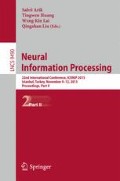Abstract
A method of finding frequently occurring patterns in spike trains is proposed. Due to stochastic fluctuation, patterns do not appear in exactly the same way. Therefore spike train subsequences are clustered using a similarity measure based on a positive definite kernel for alignments of local interval structures. By applying the method to synthetic data, spike trains generated from different neuron types are classified correctly. For synthetic and real data, patterns that repeatedly appear were successfully extracted.
Access this chapter
Tax calculation will be finalised at checkout
Purchases are for personal use only
References
Abeles, M.: Local Cortical Circuits: An Electrophysiological Study. Springer, Heidelberg (1982)
Baram, Y.: Global attractor alphabet of neural firing modes. J. Neurophysiol. 110, 907–915 (2013)
Cuturi, M.: Fast global alignment kernels. In: Proceedings of the 28th International Conference in Machine Learning, pp. 929–936 (2011)
Gerstein, G.L., Williams, E.R., Diesmann, M., Grün, S., Trengove, C.: Detecting synfire chains in parallel spike data. J. Neurosci. Methods 206, 54–64 (2012)
Grün, S., Diesmann, M., Aertsen, A.: Unitary events in multiple single-neuron spiking activity: I. detection and significance. Neural Comput. 14, 43–80 (2001)
Ikegaya, Y., Aaron, G., Cossart, R., Aronov, D., Lampl, I., Ferster, D., Yuste, R.: Synfire chains and cortical songs: temporal modules of cortical activity. Science 304, 559–564 (2004)
Izhikevich, E.M.: Which model to use for cortical spiking neurons? IEEE Trans. Neural Netw. 15(5), 1063–1070 (2004)
Laxman, S., Sastry, P.S., Unnikrishnan, K.P.: A fast algorithm for finding frequent episodes in event streams. In: Proceedings of the 13th ACM SIGKDD International Conference on Knowledge Discovery and Data Mining, pp. 410–419 (2007)
Lee, A.K., Wilson, M.A.: A combinatorial method for analyzing sequential firing patterns involving an arbitrary number of neurons based on relative time order. J. Neurophysiol. 92, 2555–2573 (2004)
Mannila, H., Toivonen, H., Verkamo, A.I.: Discovery of frequent episodes in event sequences. Data Min. Knowl. Discov. 1(3), 259–289 (1997)
Mizuseki, K., Sirota, A., Pastalkova, E., Buzsáki, G.: Theta oscillations provide temporal windows for local circuit computation in the entorhinal-hippocampal loop. Neuron 64, 267–280 (2009)
Picado Muiño, D., Castro León, I., Borgelt, C.: Fuzzy frequent pattern mining in spike trains. In: Hollmén, J., Klawonn, F., Tucker, A. (eds.) IDA 2012. LNCS, vol. 7619, pp. 289–300. Springer, Heidelberg (2012)
Srikanth, R., Agrawal, R.: Mining sequential patterns: generalizations and performance improvements. In: Apers, P., Bouzeghoub, M., Gardarin, G. (eds.) Proceedings of the 5th International Conference on Extending Database Technology. Lecture Notes in Computer Science, vol. 1057, pp. 3–17. Springer, Heidelberg (1996)
Torre, E., Picado-Muino, D., Denker, M., Borgelt, C., Grün, S.: Statistical evaluation of synchronous spike patterns extracted by frequent item set mining. Front. Comput. Neurosci. 22 (2013)
Toups, J.V., Tiesinga, P.H.E.: Methods for finding and validating neural spike patterns. Neurocomputing 69, 1362–1365 (2006)
Unnikrishnan, K.P., Patnaik, D., Sastry, P.S.: Discovering patterns in multi-neuronal spike trains using the frequent episode method. Computing Research Repository (2007)
van Rossum, M.C.W.: A novel spike distance. Neural Comput. 13, 751–763 (2001)
Victor, J.D., Purpura, K.P.: Nature and precision of temporal coding in visual cortex: a metric-space analysis. J. Neurophysiol. 76, 1310–1326 (1996)
Acknowledgements
This work was supported in part by JSPS KAKENHI Grant Numbers 21700121, 25280110, and 25540159.
Author information
Authors and Affiliations
Corresponding author
Editor information
Editors and Affiliations
Rights and permissions
Copyright information
© 2015 Springer International Publishing Switzerland
About this paper
Cite this paper
Tezuka, T. (2015). Spike Train Pattern Discovery Using Interval Structure Alignment. In: Arik, S., Huang, T., Lai, W., Liu, Q. (eds) Neural Information Processing. ICONIP 2015. Lecture Notes in Computer Science(), vol 9490. Springer, Cham. https://doi.org/10.1007/978-3-319-26535-3_28
Download citation
DOI: https://doi.org/10.1007/978-3-319-26535-3_28
Published:
Publisher Name: Springer, Cham
Print ISBN: 978-3-319-26534-6
Online ISBN: 978-3-319-26535-3
eBook Packages: Computer ScienceComputer Science (R0)

